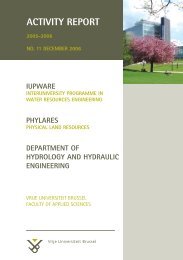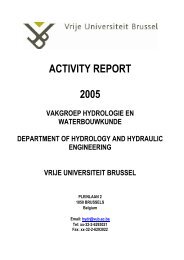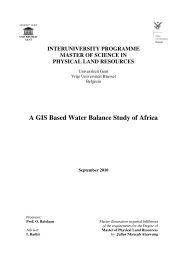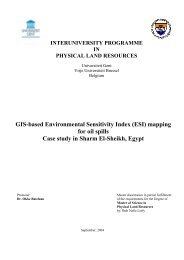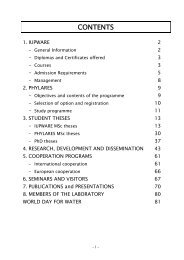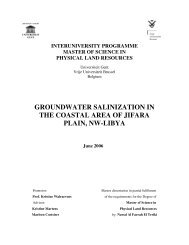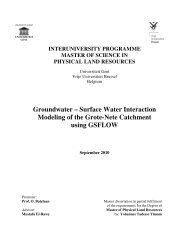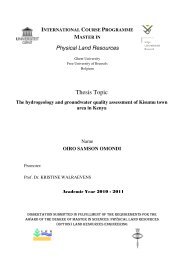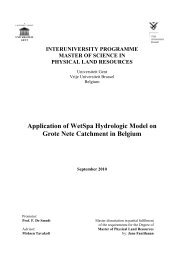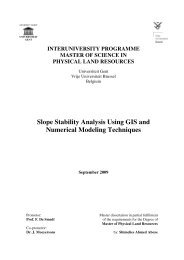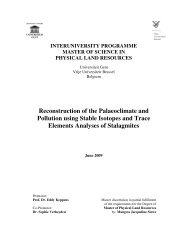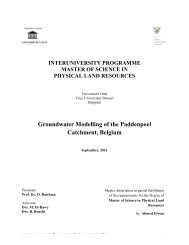Surface Water Interaction Modelling Using Visual MODFLOW and GIS
Surface Water Interaction Modelling Using Visual MODFLOW and GIS
Surface Water Interaction Modelling Using Visual MODFLOW and GIS
- No tags were found...
You also want an ePaper? Increase the reach of your titles
YUMPU automatically turns print PDFs into web optimized ePapers that Google loves.
PHYLARES<strong>Interaction</strong> of Groundwater <strong>and</strong> <strong>Surface</strong> water / ch.3__________________________________________________________________________________________173.3. <strong>Interaction</strong> of Groundwater <strong>and</strong> LakesLakes, both natural <strong>and</strong> human made, are present in many different parts of l<strong>and</strong>scapes <strong>and</strong> canhave complex ground-water-flow systems associated with them. Lakes interact with groundwater in one of three basic ways: some receive ground-water inflow throughout their entire bed;some have seepage loss to ground water throughout their entire bed; <strong>and</strong> others, perhaps mostlakes, receive ground-water inflow through part of their bed <strong>and</strong> have seepage loss to groundwater through other parts. Lowering of lake levels as a result of ground-water pumping can affectthe ecosystems supported by the lake diminish lakefront esthetics, <strong>and</strong> have negative effects onshoreline structures such as docks.The chemistry of ground water <strong>and</strong> the direction <strong>and</strong> magnitude of exchange with surface watersignificantly affect the input of dissolved chemicals to lakes. In fact, ground water can be theprincipal source of dissolved chemicals to a lake, even in cases where ground-water discharge isa small component of a lake's water budget. Changes in flow patterns to lakes as a result ofpumping may alter the natural fluxes to lakes of key constituents such as nutrients <strong>and</strong> dissolvedoxygen, in turn altering lake biota, their environment, <strong>and</strong> the interaction of both.3.4 <strong>Interaction</strong> of Groundwater <strong>and</strong> Wetl<strong>and</strong>sWetl<strong>and</strong>s occur in widely diverse settings from coastal margins to flood plains to mountainvalleys. Similar to streams <strong>and</strong> lakes, wetl<strong>and</strong>s can receive ground-water inflow, recharge groundwater, or do both. Public <strong>and</strong> scientific views of wetl<strong>and</strong>s have changed greatly over time.Wetl<strong>and</strong>s generally were considered to be of little or no value. It is now recognized that wetl<strong>and</strong>shave beneficial functions such as wildlife habitat, floodwater retention, protection of the l<strong>and</strong>from erosion, shoreline protection in coastal areas, <strong>and</strong> water-quality improvement by filtering ofcontaminants.The persistence, size, <strong>and</strong> function of wetl<strong>and</strong>s are controlled by hydrologic processes (Carter,1996). Characterizing ground-water discharge to wetl<strong>and</strong>s <strong>and</strong> its relation to environmentalfactors such as moisture content <strong>and</strong> chemistry in the root zone of wetl<strong>and</strong> plants is a criticalaspect of wetl<strong>and</strong>s hydrology (Hunt et.al, 1999).Wetl<strong>and</strong>s can be quite sensitive to the effects ofground-water pumping. Ground-water pumping can affect wetl<strong>and</strong>s not only as a result of______________________________________________________________________________________Groundwater – <strong>Surface</strong> water interaction modeling using visual <strong>MODFLOW</strong> <strong>and</strong> <strong>GIS</strong>




